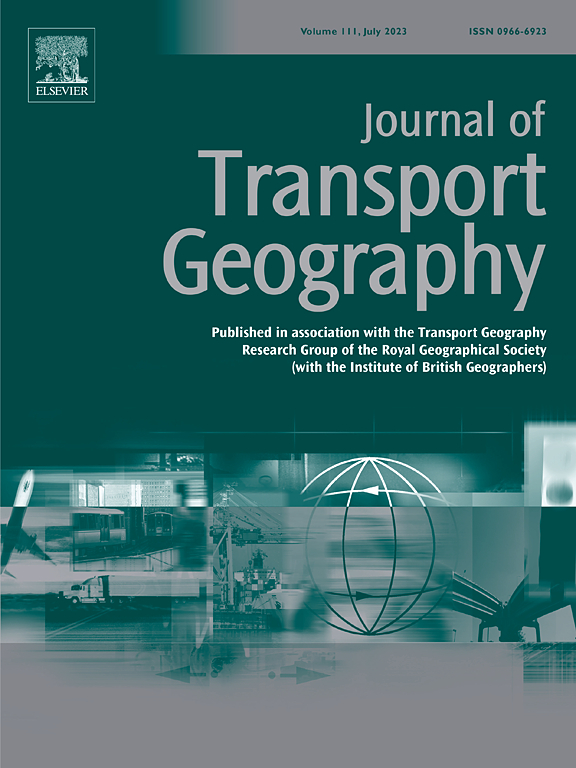Decoding mobility hubs: Opportunities and risks underpinning their introduction for the contexts of transport and the wider society
IF 6.3
2区 工程技术
Q1 ECONOMICS
引用次数: 0
Abstract
In an era, where, on the one hand, climate change constitutes a planet-defining threat but, on the other, technology provides unprecedented opportunities for connectivity, sharing and intelligence in transport, mobility hubs have emerged as a potential cornerstone for less car-dominated societies. Still in their infancy as a brand, mobility hubs promise to be visible, accessible, and integration-enabling spaces, where public transit, shared mobility, micromobility and active travel modes co-exist harmoniously alongside infrastructure facilities like charging and sharing stations. Yet, there are still genuine question marks around their implementation, functionality, urban fit and use. Can mobility hubs create opportunities to address effectively transport and even wider societal challenges? Are there any risks or potential side-effects when adopting them? This paper attempts to provide answers by critically reviewing the existing literature and conducting a thematic narrative analysis, identifying and contextualising the opportunities and risks behind mobility hubs' introduction, adoption and travel behaviour impact. According to our research mobility hubs, if designed appropriately, can assume positive roles becoming: an opponent for private car, a solution for any geography, a MaaS companion, a place of social abundance and a supporter of wider economy. If they are not, though, mobility hubs may be instead responsible for: environmental burdens, public indifference, discomfort by default, abuse of space and inequity problems. Our work provides a genuine platform for decoding the potential of mobility hubs exploring the often-neglected grey sides of this shared transport phenomenon by focusing not only in new, niche, shared micromobility-centric investments but also looking at rebranded transit-based mechanisms. If these opportunities are seized and side-effects avoided, then there could be a powerful business case for mobility hubs we argue.
解读交通枢纽:在交通和更广泛的社会背景下引入交通枢纽的机遇和风险
在这个时代,一方面,气候变化构成了一个定义地球的威胁,但另一方面,技术为交通运输的连接、共享和智能提供了前所未有的机会,移动枢纽已经成为汽车主导程度较低的社会的潜在基石。作为一个品牌,移动枢纽仍处于起步阶段,它有望成为一个可见、可访问、可整合的空间,在这里,公共交通、共享出行、微出行和主动出行模式与充电和共享站等基础设施和谐共存。然而,在它们的实施、功能、城市适用性和使用方面,仍然存在真正的问号。交通枢纽能否创造机会,有效解决交通问题,甚至更广泛的社会挑战?采用它们是否有任何风险或潜在的副作用?本文试图通过批判性地回顾现有文献并进行主题叙事分析,识别和背景化交通枢纽引入、采用和旅行行为影响背后的机会和风险,从而提供答案。根据我们的研究,如果设计得当,移动中心可以扮演积极的角色:私家车的对手,任何地理位置的解决方案,MaaS的伴侣,社会丰富的地方和更广泛经济的支持者。然而,如果不是这样,交通枢纽可能会对环境负担、公众冷漠、默认的不适、空间滥用和不平等问题负责。我们的工作为解读交通枢纽的潜力提供了一个真正的平台,通过不仅关注新的、利基的、以共享微交通为中心的投资,而且关注重新命名的基于交通的机制,探索这种共享交通现象中经常被忽视的灰色方面。我们认为,如果抓住这些机会并避免副作用,那么移动枢纽可能会有一个强大的商业案例。
本文章由计算机程序翻译,如有差异,请以英文原文为准。
求助全文
约1分钟内获得全文
求助全文
来源期刊

Journal of Transport Geography
Multiple-
CiteScore
11.50
自引率
11.50%
发文量
197
期刊介绍:
A major resurgence has occurred in transport geography in the wake of political and policy changes, huge transport infrastructure projects and responses to urban traffic congestion. The Journal of Transport Geography provides a central focus for developments in this rapidly expanding sub-discipline.
 求助内容:
求助内容: 应助结果提醒方式:
应助结果提醒方式:


